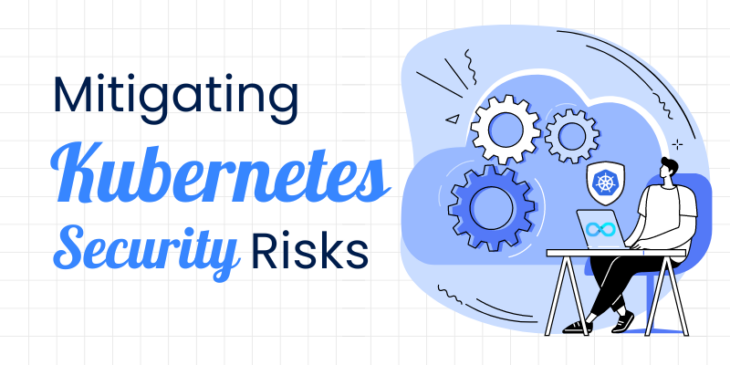
Among the many challenges that enterprises have to handle with Kubernetes deployment, security is one of them. In the current disruptive and highly competitive market, Kubernetes-related security attacks and incidents are on the rise. Many organizations are forced to hold back on their business plans because of their Kubernetes-related security concerns and partly for their inability to resolve them.
Explore the intricate landscape of Kubernetes security challenges and discover proactive strategies for effective mitigation. From container vulnerabilities to access control, delve into practical insights aimed at fortifying your Kubernetes infrastructure, here, in this blog.
Exploring K8s Security Challenges
Integration of security checks to resolve security issues can’t be an afterthought. The security practices need to be embedded in the DevOps process – generally referred to as “DevSecOps”. While talking about Kubernetes challenges here, or Kubernetes DevSecOps, Product teams need to plan for securing the containerized environment across the entire DevOps life cycle, which includes the build, deploy and run phases of an application.
Lately, security concerns have come out as one of the significant Kubernetes challenges for enterprises planning to deploy Kubernetes. When it comes to singling out significant security challenges, it won’t be wrong to consider these as the major barriers to implementing Kubernetes. Let’s hash these out.
Communication between the Pods
The entire Kubernetes deployment comes down to pods or groups of one or more containers. Pods are the smallest deployable units of computing that can be created and managed within Kubernetes. A pod comprises the shared storage & network resources and a specification for how to run the containers.
It makes sense that enterprises’ efforts for resolving Kubernetes-related security concerns should begin here. Pod communication is an issue. Since all pods are non-isolated by default and accept traffic from any source. Thus, the intrusion of external malicious entities can take advantage of the fact and use the communication properties of the pod to contaminate the remaining pods.
This creates a problem in access control. Access control is determining who gets what kind of access to particular data. Restricting access to confidential systems or data helps in preventing risks associated with data exposure.
Runtime Security Threats
Enterprises need to be aware of runtime security threats for a secured and hassle-free Kubernetes deployment. The runtime phase of Kubernetes deployment exposes containerized applications to a chunk of security threats that happen in real time. As a result, a compromised container can execute a malicious process that ultimately affects the other containers in the environment and the entire container orchestration process.
A survey shows that 94% of organizations have experienced a serious security issue in the last 12 months in their container environment, with
- 69% having detected misconfiguration
- 27 % experiencing runtime security incidents
- 24 % discover significant vulnerabilities to remediate
Comprehensive Kubernetes monitoring and checking container activities can help organizations tackle these security-related Kubernetes challenges. Enterprises should primarily focus on network traffic to restrict and prevent unnecessary or insecure communication, as specified by their network policies. They can then use this data to harden the conditions of their network policies even further. Leveraging popular Kubernetes DevSecOps approaches can help in overcoming these challenges.
Best K8s Security Practices
To restrict the exposure of containerized applications from security threats and malicious attacks, Kubernetes DevSecOps practices can be leveraged. Here are a few recommended approaches and best practices to adopt to resolve security issues and extract the most out of the Kubernetes advantages and quick delivery of applications.
Image Scanning Process: Integrate an image-scanning process to prevent vulnerabilities in the applications. Include the process as a part of the continuous integration/continuous delivery (CI/CD). Doing this makes sure that all the enterprise applications are scanned during the build and run phases of the software development life cycle.
- CIS Benchmarks: Tighten the configurations for Kubernetes monitoring and detecting threats and vulnerabilities by using Center for Internet Security (CIS) benchmarks, which are available for Kubernetes, to enable a strong security system.
- Access Control: Restrict access to confidential systems or data. It helps to mitigate potential threats and risks associated with data exposure.
- RBAC: Enable Kubernetes role-based access control (RBAC). Kubernetes RBAC controls the access authorization and also restricts access to a cluster’s Kubernetes API servers, both for service accounts and for users in the cluster.
- Secrets Management: Deploy tools and methods for managing digital authentication credentials (known as secrets), including passwords, keys, APIs, and tokens for getting access to applications, services, and other sensitive parts of the enterprise.
Key Takeaway
Security is an important aspect that needs to be taken care of right from the start. Ignoring potential security risks can expose applications to damaging threats leading to serious consequences. Considering effective security practices for container orchestration can fasten the delivery process and help businesses with enhanced agility and greater ROI. Platforms like BuildPiper can enable this out of the box and make your Kubernetes & Microservices Journey, hugely rewarding!



